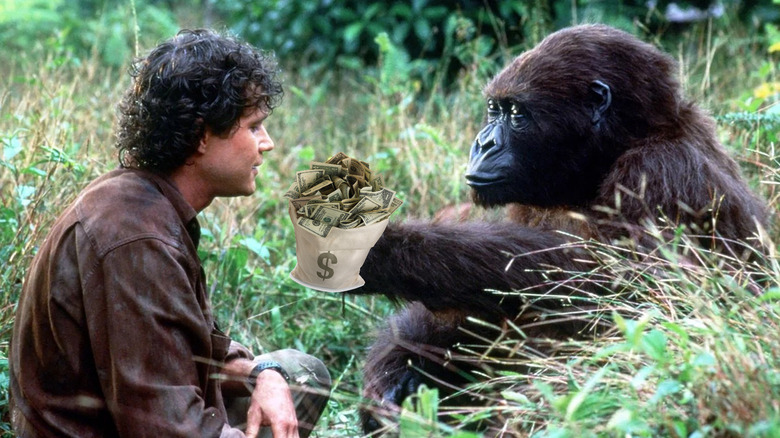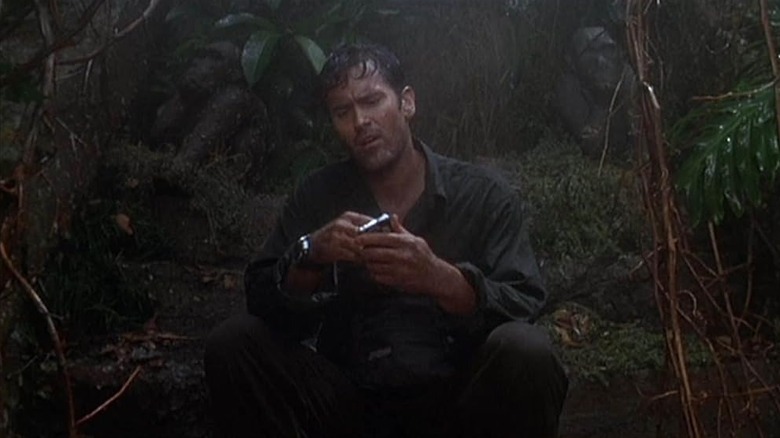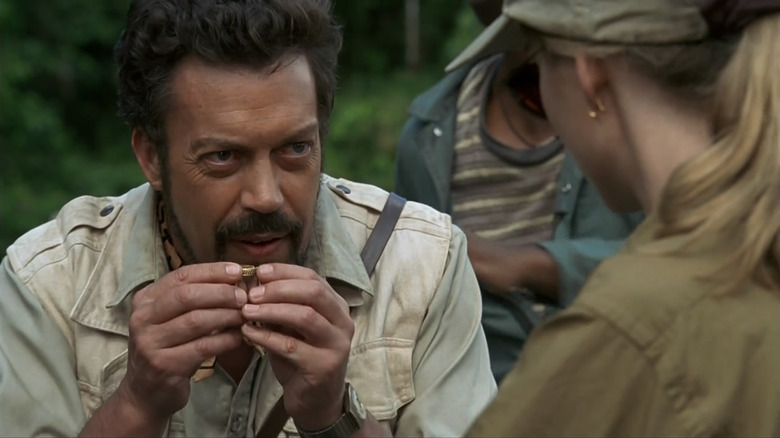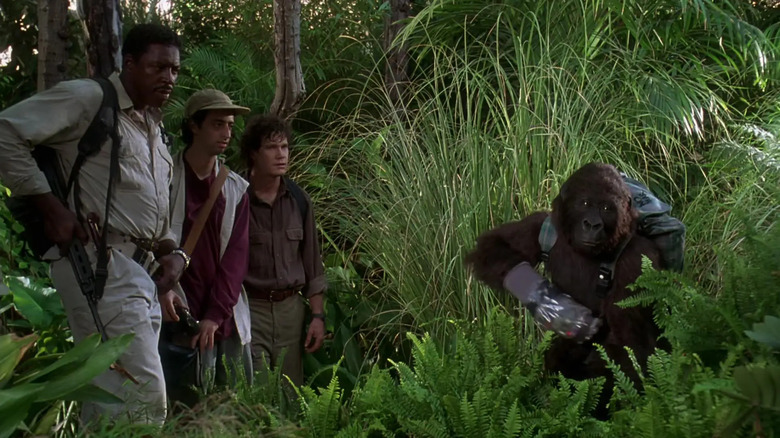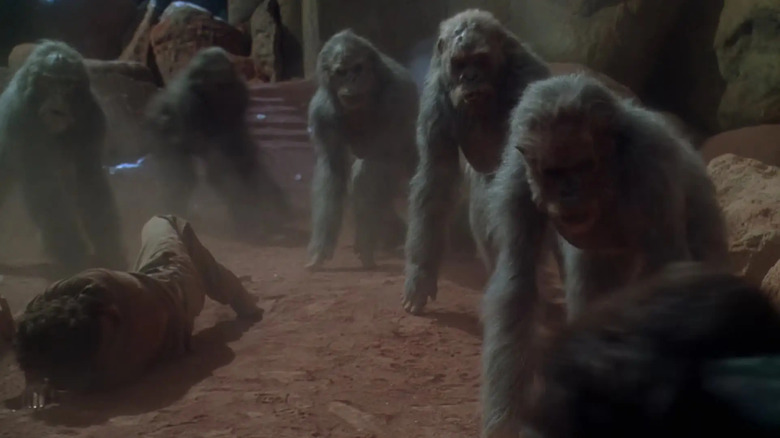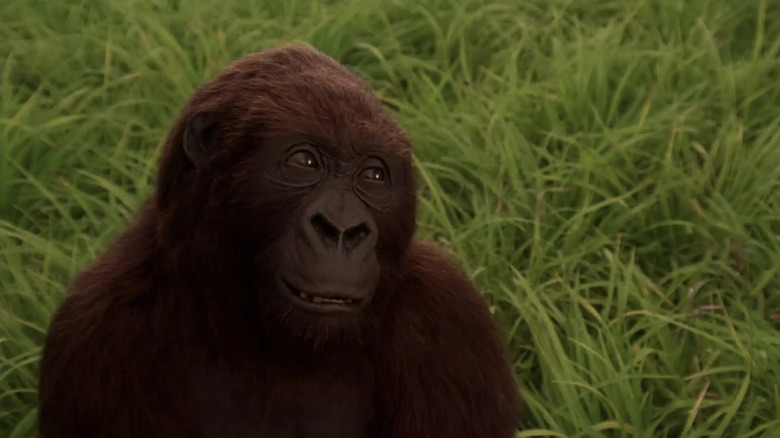The Infamous Critical Flop That Failed To Capture Jurassic Park's Box Office Magic
We may receive a commission on purchases made from links.
(Welcome to Tales from the Box Office, our column that examines box office miracles, disasters, and everything in between, as well as what we can learn from them.)
"In every frame, it aspires to be a theme park." Those are the words of critic Hal Hinson writing in 1995 for The Washington Post about director Frank Marshall's "Congo." Hinson was certainly not alone in his dismissal of the film, which was met with scathing reviews upon its release 30 years ago. Ironically, the film in question was made in direct response to the success of "Jurassic Park," a movie about making a dinosaur theme park, one also based on the works of Author Michael Crichton.
If there is one thing Hollywood will reliably do just about 100% of the time, it's attempting to recapture success. Because "X-Men" was a big hit in 2000, Sam Raimi's "Spider-Man" got made, among many other less memorable superhero films in the early 2000s. The success of John Carpenter's '78 horror classic "Halloween" helped popularize the slasher as we know it, with movies like "Friday the 13th" and "My Bloody Valentine" following in its wake. There are countless examples.
"Congo" was a prime instance in the mid-'90s, with Paramount Pictures hoping to recapture some of that very same magic that made Steven Spielberg's "Jurassic Park" into the biggest movie of all time up to that point in 1993. They had Crichton. They had the same producers. They had a great cast. What they didn't have? A good movie to show for it.
In this week's Tales from the Box Office, we're looking back at "Congo" in honor of its 30th anniversary. We'll go over how it came to be, how it fell into a lot of common traps in attempting to emulate success, what happened when it hit theaters, what happened in the aftermath of its release, and what lessons we can learn from it all these years later. Let's dig in, shall we?
The movie: Congo
The film centers on Scientist Karen Ross (Laura Linney), who is sent by her father-in-law (Joe Don Baker) to the Congo to find his son's missing diamond-hunting team. A ragtag team led by expert guide Kelly (Ernie Hudson) that also includes primatologist Dr. Peter Elliot (Dylan Walsh), treasure hunter Herkermer Homolka (Tim Curry), and a very smart gorilla named Amy, discover various dangers in the jungle before encountering a pack of dangerous, violent gray gorillas.
"It's a little like Alien at the beginning, in that it's based in science fact, and like Indiana Jones at the end, with the lost city of Zinj," director Frank Marshall said to Star News in June of '95. He clearly wasn't afraid of setting high expectations. And why should he be? Marshall was one of Hollywood's top producers and helped turn "Jurassic Park" into a game-changing $1 billion success story. He had another Crichton story and Kathleen Kennedy, a frequent Spielberg producing partner, on board as well. What could go wrong?
Well, for one, "Congo" had been kicking around Hollywood for a long time, with Chrichton originally planning to direct it himself. Despite being known best as an author, Crichton had directed movies like "Westworld" to great success. Crichton sold the movie rights to Fox before the book had even been finished, speaking volumes about the success he had achieved with "The Andromeda Strain" and "The Great Train Robbery."
Congo was in development hell for years
By the mid-'80s, Crichton and Fox were looking to make "Congo" a reality after the novel, published in 1980, had become a huge hit. There were several major problems, though. For one, Crichton was determined to have an actual ape play Amy, the intelligent ape who uses sign language to communicate with humans.
"Congo requires four characters, and one is an animal who's on screen all the time for the whole movie," Crichton said at the time (via Den of Geek). She better be charming, and you better not see human eyes. You can't have Rick Baker in a monkey suit." Baker is one of the most legendary VFX artists in Hollywood history, which helps drive Chrichton's point home. This created problems. As the author explained to Starlog in 1984, they simply couldn't make it work:
"We went into pre-production and discovered that there were no gorillas at all anywhere in the world which were available for work in a film. There are some gorillas used in research. We attempted to hire them and we couldn't. Gorillas aren't like chimps at all. They are an endangered species."
Eventually, Crichton moved on, with the likes of Spielberg and other directors spending time with the project. It was believed that Crichton had envisioned Sean Connery for the lead role, but that was never confirmed.
Jurassic Park finally helps make Congo a reality
Eventually, when buzz was building for "Jurassic Park" in 1992, Marshall and Kennedy wrestled the rights to "Congo" away from Fox and set up the project at Paramount. John Patrick Shanley ("Alive") took over scripting duties, with Crichton having very little to say about this iteration of the project. Against his wishes, armed with a sizable $50 million budget, they hired the legendary Stan Winston to craft state of the art animatronic monkey suits for the film.
"Congo was kind of a proving ground for me," Winston said in a behind the scenes breakdown for The Stan Winston School of Character Arts. "Or, at least, that's what I had wanted it to be. I wanted to show the world that we could do gorillas, too, and do them well."
Marshall, who previously directed the creature feature "Arachnophobia," was trying to execute the same playbook they did with "Jurassic Park." Assemble a compelling cast of solid actors and craft visual effects that will essentially serve as the movie's star. The problem, as Crichton feared, is that the apes didn't resonate in the way they had hoped. Speaking further, Winston revealed that some of the creative license they took with Amy and the other apes might have been a bridge too far:
"We took a lot of artistic license with Amy that, in hindsight, we shouldn't have taken. Part of that artistic license was putting a lowland gorilla face on what was supposed to be a mountain gorilla, just to make her more appealing. She was cuter, but we paid a price for it because there was a sense of reality that was lost in the character."
The financial journey
Naturally, Paramount tried to turn "Congo" into the "Jurassic Park" of the summer of '95. This included a massive marketing campaign, product tie-ins with the likes of Pepsi and Taco Bell, the whole shebang. The trailers very much tried to offer a "Raiders of the Lost Ark with apes" vibe, with the initial teaser attached to the VHS release of "Forrest Gump." That undoubtedly helped with awareness. The studio gave it a prime summer release date in the second weekend of June. Critical consensus be damned, it proved to be money well spent, at least in the short term.
Released on the weekend of June 9, 1995, Marshall's adaptation of Crichton's novel opened atop the box office with a much bigger-than-expected $24.6 million. The opening was Paramount's biggest of all time up to that point, with analysts at the time expressing surprise. "Ape tale 'Congo' opens huge despite bad reviews," the Los Angeles Times wrote at the time.
Indeed, the bad reviews couldn't dissuade audience curiosity, though the party atop the charts was short-lived, as Joel Schumacher's "Batman Forever" starring Val Kilmer took the number one spot the following weekend with a massive $52.7 million opening. In the weeks that followed, the likes of "Pocahontas," "Apollo 13," and "Clueless," among others, would take the spotlight.
Be that as it may, "Congo" finished its run with $81 million domestically to go with $71 million internationally for a grand total of $152 million.
Congo was the worst kind of superficial success story
That paled in comparison to "Jurassic Park," which made $978 million in its original run and led to a $6 billion franchise that is still going strong to this day. The movie also failed to make the list of the top 20 highest-grossing movies of 1995 globally overall, with the likes of "Die Hard: With a Vengeance" ($366 million), Pixar's groundbreaking animated hit "Toy Story" ($365 million), and Pierce Brosnan's first "James Bond" movie "GoldenEye" ($356 million).
All the same, it made money for Paramount in its day. It was by no means a flop, but it was a critical disaster that made its money quickly and was rapidly overshadowed by movies that have endured far better in the pop culture consciousness. It's telling that there was no sequel. It's telling that Crichton didn't have much to say about it in the lead-up to the release. Despite languishing in development hell for years on end, this movie ultimately was made for the least creative reasons imaginable.
Sure, some enjoy "Congo" as a campy relic of its time. It even secured a 4K Ultra HD release recently. But it's by no means some enduring classic. It wasn't groundbreaking like the movie it was trying to emulate. It was a superficial cash grab, one that purchased its audience rather than winning them over. With the benefit of hindsight, it feels like Paramount got away with one here.
The lessons contained within
There's nothing wrong, inherently, with looking at another success story in the realm of Hollywood filmmaking and trying to figure out why that worked, then attempting to apply those lessons to another endeavor in the realm of major motion pictures. It's another thing entirely to go, "make me 'Jurassic Park' but with apes." That sort of thinking rarely yields great results.
Just look at what happened with DC in the lead-up to "Justice League" while Warner Bros. was trying to catch up with Marvel in the cinematic universe game. Madness that way lies. It feels a little wrong, looking back, that Crichton had a real passion for the material that he generated, and a vision for it, only for other filmmakers to come in and execute it precisely in the way he imagined it shouldn't be done. It's things like this that make me increasingly impressed that we didn't get 50 killer clown movies after "It" became such a big success in 2017.
There's a reason that "Jurassic Park" sparked a bidding war in Hollywood ahead of its release. Filmmakers like Joe Dante, Tim Burton, and Steven Spielberg were offered that creative spark by the words on the page. It spoke to them and, in the end, resulted in a remarkable cinematic achievement. "Congo," on the other hand, exists simply because that movie was a hit and a rival studio wanted in on the windfall. Sure, Paramount got a slice of the pie, but it wasn't a particularly big slice. Any success, in such cases, only serves to enforce the worst type of thinking that exists in this business. Therein lies the danger.
